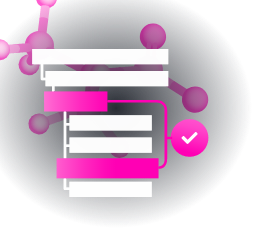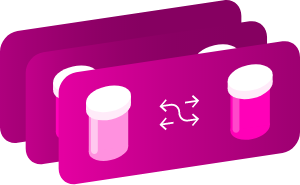识别
- Generic Name
- Dansyllysine
- DrugBank Accession Number
- DB04676
- Background
-
Not Available
- Type
- Small Molecule
- Groups
- Experimental
- Structure
- Weight
-
Average: 379.474
Monoisotopic: 379.156576993 - Chemical Formula
- C18H25N3O4S
- Synonyms
-
- DNS-lysine
- N(epsilon)-Dansyl-L-lysine
Pharmacology
- Indication
-
Not Available
 Reduce drug development failure ratesBuild, train, & validate machine-learning models
Reduce drug development failure ratesBuild, train, & validate machine-learning models
with evidence-based and structured datasets.Build, train, & validate predictive machine-learning models with structured datasets. - Contraindications & Blackbox Warnings
-
 Avoid life-threatening adverse drug eventsImprove clinical decision support with information oncontraindications & blackbox warnings, population restrictions, harmful risks, & more.Avoid life-threatening adverse drug events & improve clinical decision support.
Avoid life-threatening adverse drug eventsImprove clinical decision support with information oncontraindications & blackbox warnings, population restrictions, harmful risks, & more.Avoid life-threatening adverse drug events & improve clinical decision support. - Pharmacodynamics
-
Not Available
- Mechanism of action
-
Target Actions Organism UIg alpha-2 chain C region Not Available Humans - Absorption
-
Not Available
- Volume of distribution
-
Not Available
- Protein binding
-
Not Available
- Metabolism
- Not Available
- Route of elimination
-
Not Available
- Half-life
-
Not Available
- Clearance
-
Not Available
- Adverse Effects
-
 Improve decision support & research outcomesWith structured adverse effects data, including:blackbox warnings, adverse reactions, warning & precautions, & incidence rates.Improve decision support & research outcomes with our structured adverse effects data.
Improve decision support & research outcomesWith structured adverse effects data, including:blackbox warnings, adverse reactions, warning & precautions, & incidence rates.Improve decision support & research outcomes with our structured adverse effects data. - 毒性
-
Not Available
- Pathways
- Not Available
- Pharmacogenomic Effects/ADRsBrowse all" title="" id="snp-actions-info" class="drug-info-popup" href="javascript:void(0);">
- Not Available
Interactions
- Drug InteractionsLearn More" title="" id="structured-interactions-info" class="drug-info-popup" href="javascript:void(0);">
-
This information should not be interpreted without the help of a healthcare provider. If you believe you are experiencing an interaction, contact a healthcare provider immediately. The absence of an interaction does not necessarily mean no interactions exist.Not Available
- Food Interactions
- Not Available
Categories
- Drug Categories
- Chemical TaxonomyProvided byClassyfire
-
- Description
- This compound belongs to the class of organic compounds known as 1-naphthalene sulfonic acids and derivatives. These are organic aromatic compounds that contain a naphthalene moiety that carries a sulfonic acid group (or a derivative thereof) at the 1-position. Naphthalene is a bicyclic compound that is made up of two fused benzene ring.
- Kingdom
- Organic compounds
- Super Class
- Benzenoids
- Class
- Naphthalenes
- Sub Class
- Naphthalene sulfonic acids and derivatives
- Direct Parent
- 1-naphthalene sulfonic acids and derivatives
- Alternative Parents
- 1-naphthalene sulfonamides/L-alpha-amino acids/Medium-chain fatty acids/Dialkylarylamines/Organosulfonamides/Aminosulfonyl compounds/Amino acids/Monocarboxylic acids and derivatives/Carboxylic acids/Organopnictogen compounds show 4 more
- Substituents
- 1-naphthalene sulfonamide/1-naphthalene sulfonic acid or derivatives/Alpha-amino acid/Alpha-amino acid or derivatives/Amine/Amino acid/Amino acid or derivatives/Aminosulfonyl compound/Aromatic homopolycyclic compound/Carbonyl group show 25 more
- Molecular Framework
- Aromatic homopolycyclic compounds
- External Descriptors
- non-proteinogenic L-alpha-amino acid, L-lysine derivative (CHEBI:42024)
- Affected organisms
- Not Available
Chemical Identifiers
- UNII
- EFF64524YR
- CAS number
- 1101-84-4
- InChI Key
- VQPRNSWQIAHPMS-HNNXBMFYSA-N
- InChI
-
InChI = 1 s / C18H25N3O4S c1-21 (2) 16 -10-5-8-14-13(16)7-6-11-17(14)26(24,25)20-12-4-3-9-15(19)18(22)23/h5-8,10-11,15,20H,3-4,9,12,19H2,1-2H3,(H,22,23)/t15-/m0/s1
- IUPAC Name
-
(2S)-2-amino-6-[5-(dimethylamino)naphthalene-1-sulfonamido]hexanoic acid
- SMILES
-
CN(C)C1=CC=CC2=C1C=CC=C2S(=O)(=O)NCCCC[C@H](N)C(O)=O
References
Clinical Trials
- Clinical TrialsLearn More" title="" id="clinical-trials-info" class="drug-info-popup" href="javascript:void(0);">
-
Phase Status Purpose Conditions Count
Pharmacoeconomics
- Manufacturers
-
Not Available
- Packagers
-
Not Available
- Dosage Forms
- Not Available
- Prices
- Not Available
- Patents
- Not Available
Properties
- State
- Solid
- Experimental Properties
- Not Available
- Predicted Properties
-
Property Value Source Water Solubility 0.0782 mg/mL ALOGPS logP -0.68 ALOGPS logP -0.45 Chemaxon logS -3.7 ALOGPS pKa (Strongest Acidic) 1.54 Chemaxon pKa (Strongest Basic) 9.38 Chemaxon Physiological Charge 0 Chemaxon Hydrogen Acceptor Count 6 Chemaxon Hydrogen Donor Count 3 Chemaxon Polar Surface Area 112.73 Å2 Chemaxon Rotatable Bond Count 8 Chemaxon Refractivity 101.88 m3·mol-1 Chemaxon Polarizability 40.79 Å3 Chemaxon Number of Rings 2 Chemaxon Bioavailability 1 Chemaxon Rule of Five Yes Chemaxon Ghose Filter No Chemaxon Veber's Rule No Chemaxon MDDR-like Rule No Chemaxon - Predicted ADMET Features
-
Property Value Probability Human Intestinal Absorption + 0.9508 Blood Brain Barrier + 0.6463 Caco-2 permeable - 0.6542 P-glycoprotein substrate Substrate 0.6493 P-glycoprotein inhibitor I Non-inhibitor 0.8682 P-glycoprotein inhibitor II Non-inhibitor 0.9037 Renal organic cation transporter Non-inhibitor 0.9117 CYP450 2C9 substrate Non-substrate 0.6806 CYP450 2D6 substrate Non-substrate 0.7991 CYP450 3A4 substrate Non-substrate 0.5349 CYP450 1A2 substrate Non-inhibitor 0.726 CYP450 2C9 inhibitor Non-inhibitor 0.6895 CYP450 2D6 inhibitor Non-inhibitor 0.8629 CYP450 2C19 inhibitor Non-inhibitor 0.7321 CYP450 3A4 inhibitor Non-inhibitor 0.6292 CYP450 inhibitory promiscuity Low CYP Inhibitory Promiscuity 0.7836 Ames test Non AMES toxic 0.6818 Carcinogenicity Non-carcinogens 0.7792 Biodegradation Not ready biodegradable 1.0 Rat acute toxicity 2.3401 LD50, mol/kg Not applicable hERG inhibition (predictor I) Weak inhibitor 0.9434 hERG inhibition (predictor II) Non-inhibitor 0.6486
Spectra
- Mass Spec (NIST)
- Not Available
- Spectra
-
Spectrum Spectrum Type Splash Key Predicted MS/MS Spectrum - 10V, Positive (Annotated) Predicted LC-MS/MS Not Available Predicted MS/MS Spectrum - 20V, Positive (Annotated) Predicted LC-MS/MS Not Available Predicted MS/MS Spectrum - 40V, Positive (Annotated) Predicted LC-MS/MS Not Available Predicted MS/MS Spectrum - 10V, Negative (Annotated) Predicted LC-MS/MS Not Available Predicted MS/MS Spectrum - 20V, Negative (Annotated) Predicted LC-MS/MS Not Available Predicted MS/MS Spectrum - 40V, Negative (Annotated) Predicted LC-MS/MS Not Available
Targets

Build, predict & validate machine-learning models
Use our structured and evidence-based datasets tounlock new
insights and accelerate drug research.
insights and accelerate drug research.
Use our structured and evidence-based datasets to unlock new insights and accelerate drug research.
- Kind
- Protein
- Organism
- Humans
- Pharmacological action
-
Unknown
- General Function
- Antigen binding
- Specific Function
- Ig alpha is the major immunoglobulin class in body secretions. It may serve both to defend against local infection and to prevent access of foreign antigens to the general immunologic system.
- Gene Name
- IGHA2
- Uniprot ID
- P01877
- Uniprot Name
- Ig alpha-2 chain C region
- Molecular Weight
- 36526.005 Da
References
- Berman HM, Westbrook J, Feng Z, Gilliland G, Bhat TN, Weissig H, Shindyalov IN, Bourne PE: The Protein Data Bank. Nucleic Acids Res. 2000 Jan 1;28(1):235-42. [Article]
Drug created at September 11, 2007 17:49 / Updated at June 12, 2020 16:52



